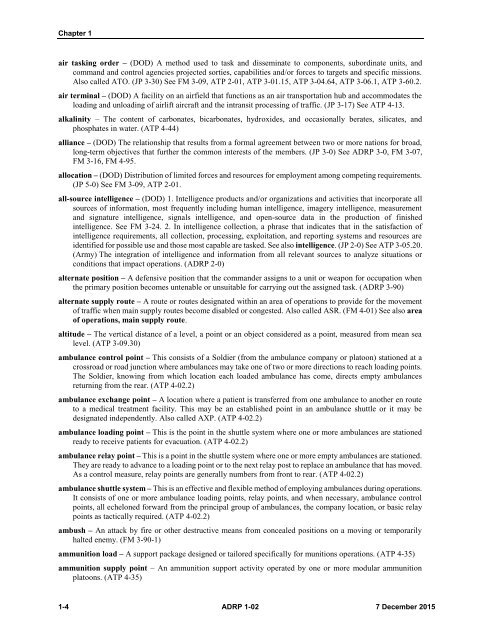ADRP1-02
52543f77c16bcfa46f6e1de2B038ef195
52543f77c16bcfa46f6e1de2B038ef195
Create successful ePaper yourself
Turn your PDF publications into a flip-book with our unique Google optimized e-Paper software.
Chapter 1<br />
air tasking order – (DOD) A method used to task and disseminate to components, subordinate units, and<br />
command and control agencies projected sorties, capabilities and/or forces to targets and specific missions.<br />
Also called ATO. (JP 3-30) See FM 3-09, ATP 2-01, ATP 3-01.15, ATP 3-04.64, ATP 3-06.1, ATP 3-60.2.<br />
air terminal – (DOD) A facility on an airfield that functions as an air transportation hub and accommodates the<br />
loading and unloading of airlift aircraft and the intransit processing of traffic. (JP 3-17) See ATP 4-13.<br />
alkalinity – The content of carbonates, bicarbonates, hydroxides, and occasionally berates, silicates, and<br />
phosphates in water. (ATP 4-44)<br />
alliance – (DOD) The relationship that results from a formal agreement between two or more nations for broad,<br />
long-term objectives that further the common interests of the members. (JP 3-0) See ADRP 3-0, FM 3-07,<br />
FM 3-16, FM 4-95.<br />
allocation – (DOD) Distribution of limited forces and resources for employment among competing requirements.<br />
(JP 5-0) See FM 3-09, ATP 2-01.<br />
all-source intelligence – (DOD) 1. Intelligence products and/or organizations and activities that incorporate all<br />
sources of information, most frequently including human intelligence, imagery intelligence, measurement<br />
and signature intelligence, signals intelligence, and open-source data in the production of finished<br />
intelligence. See FM 3-24. 2. In intelligence collection, a phrase that indicates that in the satisfaction of<br />
intelligence requirements, all collection, processing, exploitation, and reporting systems and resources are<br />
identified for possible use and those most capable are tasked. See also intelligence. (JP 2-0) See ATP 3-05.20.<br />
(Army) The integration of intelligence and information from all relevant sources to analyze situations or<br />
conditions that impact operations. (ADRP 2-0)<br />
alternate position – A defensive position that the commander assigns to a unit or weapon for occupation when<br />
the primary position becomes untenable or unsuitable for carrying out the assigned task. (ADRP 3-90)<br />
alternate supply route – A route or routes designated within an area of operations to provide for the movement<br />
of traffic when main supply routes become disabled or congested. Also called ASR. (FM 4-01) See also area<br />
of operations, main supply route.<br />
altitude – The vertical distance of a level, a point or an object considered as a point, measured from mean sea<br />
level. (ATP 3-09.30)<br />
ambulance control point – This consists of a Soldier (from the ambulance company or platoon) stationed at a<br />
crossroad or road junction where ambulances may take one of two or more directions to reach loading points.<br />
The Soldier, knowing from which location each loaded ambulance has come, directs empty ambulances<br />
returning from the rear. (ATP 4-<strong>02</strong>.2)<br />
ambulance exchange point – A location where a patient is transferred from one ambulance to another en route<br />
to a medical treatment facility. This may be an established point in an ambulance shuttle or it may be<br />
designated independently. Also called AXP. (ATP 4-<strong>02</strong>.2)<br />
ambulance loading point – This is the point in the shuttle system where one or more ambulances are stationed<br />
ready to receive patients for evacuation. (ATP 4-<strong>02</strong>.2)<br />
ambulance relay point – This is a point in the shuttle system where one or more empty ambulances are stationed.<br />
They are ready to advance to a loading point or to the next relay post to replace an ambulance that has moved.<br />
As a control measure, relay points are generally numbers from front to rear. (ATP 4-<strong>02</strong>.2)<br />
ambulance shuttle system – This is an effective and flexible method of employing ambulances during operations.<br />
It consists of one or more ambulance loading points, relay points, and when necessary, ambulance control<br />
points, all echeloned forward from the principal group of ambulances, the company location, or basic relay<br />
points as tactically required. (ATP 4-<strong>02</strong>.2)<br />
ambush – An attack by fire or other destructive means from concealed positions on a moving or temporarily<br />
halted enemy. (FM 3-90-1)<br />
ammunition load – A support package designed or tailored specifically for munitions operations. (ATP 4-35)<br />
ammunition supply point – An ammunition support activity operated by one or more modular ammunition<br />
platoons. (ATP 4-35)<br />
1-4 ADRP 1-<strong>02</strong> 7 December 2015


